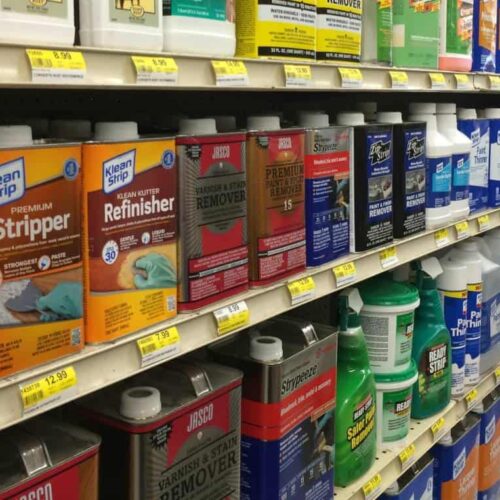Introduction
This story was updated at 3:17 p.m. with additional interviews.
In a surprise reversal, the U.S. Environmental Protection Agency said today it would enact a rule targeting a widely available type of paint remover that has killed people for decades — including at least four since last year.
It’s unclear whether the regulation would ban retail sales of these products, as the EPA proposed in the final days of the Obama administration. The agency would not clarify when asked. Today’s announcement was a turnabout for the EPA: Officials there said several weeks ago that they did not anticipate they would take final action on the issue this year, but they have come under increasing pressure from families who recently lost relatives and from members of Congress.
The products, paint removers containing methylene chloride, can kill on the spot as the chemical’s fumes build up. A 2015 Center for Public Integrity investigation, co-published with Slate, found that more than 50 people died since 1980 using methylene chloride — often in paint strippers — for work or consumer projects. To this day, Americans can purchase cans of these products at home improvement stores and other retailers, risking asphyxiation or a heart attack if they use it in enclosed areas.
At least four men died while the agency was deciding whether to enact the proposed ban, dragging out the process rather than acting swiftly — part of a pattern of deregulatory decisions by EPA Administrator Scott Pruitt. But on Tuesday, families of two of the men killed in recent months got a sit-down meeting with Pruitt. The mother of a third joined them for meetings with multiple members of Congress or their staffs this week.
Brian Wynne, whose brother Drew, 31, died using the product to refinish a floor in his business’ walk-in refrigerator in October, said senators and congressmen from both parties are helping push for action. Wynne was among the group that talked to Pruitt at EPA headquarters.
“I want to see that they’re going to do what they proposed,” Wynne said. “I’m not seeing the word ‘ban’ out there, and I want to see a ban. But we remain cautiously optimistic.”
Faye Graul, executive director of the Halogenated Solvents Industry Alliance, a trade group whose members include makers of methylene chloride, said she too has “absolutely no idea” what the EPA intends to do — or how quickly it will act.
“It’s very vague,” she said.
Graul and others in the industry have said that methylene chloride is more effective than the alternatives and should not be banned. The solvents alliance petitioned the U.S. Consumer Product Safety Commission to approve stronger warning labels for the products instead — a move that occupational-safety experts have said is not sufficient to protect lives.
In today’s announcement, the EPA said it would “shortly” send the methylene chloride rule to the White House’s Office of Management and Budget, a gatekeeper for new regulations.
“EPA is working diligently … to ensure the safety of existing chemicals,” the agency said.
However, the EPA did not specify whether its rule would include restrictions on another chemical common in paint removers, N-Methylpyrrolidone, known as NMP. The agency’s original proposal suggested either banning NMP in paint strippers or requiring lower amounts of the chemical in mixtures because it is linked to miscarriages and other harms to unborn children.
“If the NMP products stay on the shelf, they’ll replace the methylene chloride products, and that’s simply replacing one set of health risks with another,” said Liz Hitchcock, acting director of Safer Chemicals, Healthy Families, an advocacy group.
Her group, along with the Environmental Defense Fund and the Natural Resources Defense Council, is pressing both the EPA and retailers to get the products off shelves.
The most recent publicly announced death from a methylene chloride paint stripper occurred in February. Joshua Atkins, 31, was refinishing part of his BMX bicycle when he succumbed to the fumes, his mother wrote in a letter to key officials on the House Energy and Commerce Committee. Lauren Atkins said her son was visiting her in Pennsylvania at the time, and she found him slumped by the paint-remover can. Her anguish only grew as she read about methylene chloride’s tortured history.
“I learned that family after family across the country had lost loved ones to this chemical,” she wrote. “I learned that the Environmental Protection Agency had proposed banning it in paint strippers but hadn’t followed through. I learned that advocacy organizations had urged top retailers to stop selling this deadly chemical but they had refused.”
Wendy Hartley’s 21-year-old son, Kevin, died on the job last year while using a methylene chloride paint remover to refinish a bathtub. Like Wynne, Hartley was at the Pruitt meeting this week. She wants to make sure no one else dies.
“This product does not need to be on store shelves. It does not need to be in consumers’ hands. It needs to be banned,” said Hartley, of Nashville, Tennessee. “I don’t know why it hadn’t been banned before.”
READ MORE:
Members of Congress to EPA: Act now on deadly chemical
The EPA planned to ban a deadly paint-stripping chemical. Will it follow through?
Read more in Inequality, Opportunity and Poverty
Unequal Risk
Some paint strippers are killing people. The EPA promised to act — but hasn’t.
For now, the only ones yanking methylene chloride paint removers off the shelves are retailers.


Join the conversation
Show Comments
I’ve been using Aircraft brand stripper for 20 years. It is the most effective and reliable product in my body shop for its purpose. I tried it the other day without this ingredient. It is the most useless stinky horrible stuff I’ve ever seen. I don’t know what this company is going to do now. They are definitely going to go bankrupt. I suppose it’s for the best , but what a bummer. Instead of spending 30 minutes stripping the old paint off of a hood, I spent three hours sanding it off and using tons of electricity and sandpaper.… Read more »